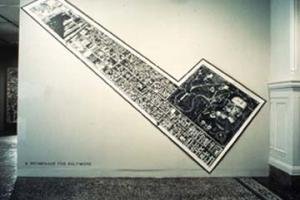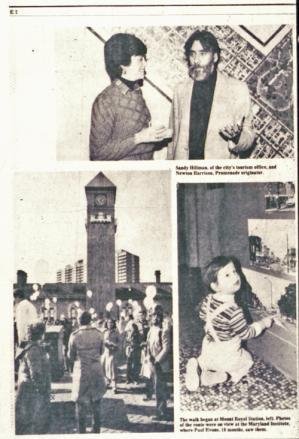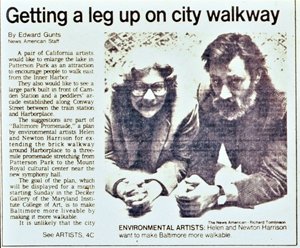Baltimore Promenade, 1981
FROM THE PERSPECTIVE OF THE HARBOR. INSTALLATION 8 FOOT BY 16 FOOT, WHERE EVERYONE CAN TOUCH THEIR HOUSES.
FROM THE PERSPECTIVE OF HOWARD ST. IMAGE 8 FOOT WHERE ALL CAN TOUCH THEIR HOUSES.
FROM THE PERSPECTIVE OF EASTERN AND PATTERSON PARK IMAGE 8 FOOT WHERE ALL CAN TOUCH THEIR HOUSES.
INSTALLATION AT MARYLAND INSTITUTE
INSTALLATION AT MARYLAND INSTITUTE
Where: Maryland Art Institute. City of Baltimore.
When: 1981
Who: Designed with students from the Maryland Institute in consultation with many City officials.
Commissioned: Maryland Institute for the Arts and supported by an NEA grant and several city agencies
This work was initiated by the Maryland Institute, supported by the National Endowment for the Arts, various city and civic agencies, and the office of the then Mayor, Schaeffer. We were originally invited to comment on a rather problematic design of inner city housing. We perceived a city divided by development at the center, partially bisected by an unfinished freeway and with a new harbor place development itself separated from the rest of the city by a heavily trafficked eight lane road. Moreover, there was violence in Center City where people perceived themselves as arbitrarily separated from the harbor where all the development money was going. Abandoned houses were sold for one dollar apiece if people agreed to maintain them. De-gentrification had taken place. The middle class had virtually abandoned the center parts of the city, and their return seemed a far distant possibility. We proposed a new unification, arguing that the city could be reconnected by generating North-South, East-West promenades which intersected at the harbor. In doing so, this work set the stage for revitalizing or redeveloping street life in the major two North-South axes.
The context: Harbor Place was being finished in Baltimore. People in the city center were angry, partly at the monies going into Harbor Place, partly at the street designs which made it very difficult for people enter from the city center on foot. There was also distress about how housing developments were interrupting the Promenade system for everyday life in the city. Our work resolved these problems by creating two new principal Promenade sites. The Mayor’s office helped design and produce a city-wide performance wherein the 3 mile Promenade site was walked on by a good many people in the city on a marvelous Saturday morning. The work was put in the city plan and the redevelopment agency immediately committed to elongating the existing street restoration on Howard Street, thus creating what is now called “the Cultural Corridor.” The work was begun as a 2,500 sq. foot installation, continued as a city-wide promenade, was almost immediately introduced into their city plan, and approximately 15 million dollars was committed by the city redevelopment agency to bring into being the Howard Street section of our work.
Originally, Baltimore Promenade was presented as an exhibition at the Maryland Institute, including a city-wide performance and a discourse in the newspapers (one article daily over a ten day period). It culminated in a parade led by the Mayor along the whole promenade route. The metaphor guiding this work was that “a promenade is a homeostatic mechanism by which the community as a whole maintains awareness of the well-being of the individuals who comprise it, and by which the sense of community is reaffirmed collectively on a daily basis.” In this context development was understood to mean energizing street life which had been suppressed by bad planning.
We proposed re-developing Howard Street, the old main shopping center of the city, beginning at the Mount Royal Center and ending with an unexpected connection leading to the harbor. With Howard Street as the north-south axis, Eastern Avenue from Patterson Park to the harbor, became the east-west axis. Hence the complex subtitle, “Two Lines of Sight and an Unexpected Connection Comprise a Promenade for Baltimore.” Each leg of the promenade was unique in quality, each about a 20 minute to half hour walk. Each leg was invisible until named.
This plan was conceptually accepted by the City Re-development Agency and a forty million dollar project begun with the north-south axis enacted in good part. Several unnecessary streets near the Maryland Institute were removed, thereby increasing the park land we called for and making a more physically unified area which, including the Maryland Institute, the Opera House and the Symphony Hall as well as a dinner theater, was obviously functioning as a cultural center. And we so named it. Thereafter, the whole of Howard Street was restated by turning a four block proposed bus mall into the mile long north-south promenade that we proposed. This street has now been labeled the cultural corridor.
The east-west axis was initiated when a small bridge at the harbor was shifted, thereby offering a line of sight from the harbor to Patterson Park along Eastern Avenue. And “From the edge of the harbor the trees at Patterson Park shown green. From the edge of Patterson Park, the tip of the aquarium sparkled like a jewel.” This area has also been called for re-development. However, to our knowledge, redevelopment has proceeded more slowly here.
From the City-wide Performance
A promenade is both an activity and a place, a stage on which people in community meet and mix. It is a leisurely meeting and mixing, having a different purposiveness and tempo than daily activities in a workplace.
A promenade is marked by people physically tuning to common movement and rhythm. A promenade is an activity common in all urban ecologies, a basic hemeostatic or self-regulating mechanism by which the community as a whole maintains awareness of the individuals who comprise it and by which the sense of community is reaffirmed collectively.
A promenade is an arena which the communal drama can be publicly enacted, an
arena to experience constancy and change, to define self and group in the context of society and time.
A promenade locale builds slowly from a first settlement, sometimes it is simply a main street speaking its patterns and its origin. A promenade always forms part of an unspoken consensus.
In times of abrupt change, a city can lose its psychological center and the promenade is displaced. The reasons are many, often economic. The result of this loss always a lessening of value, quality of life, and sense of community. As the loss becomes clear, its consequences are manifest and solutions sought.
HOWARD ST. UNDER CONSTRUCTION
HOWARD ST. BECOMES THE CULTURAL CORRIDOR











